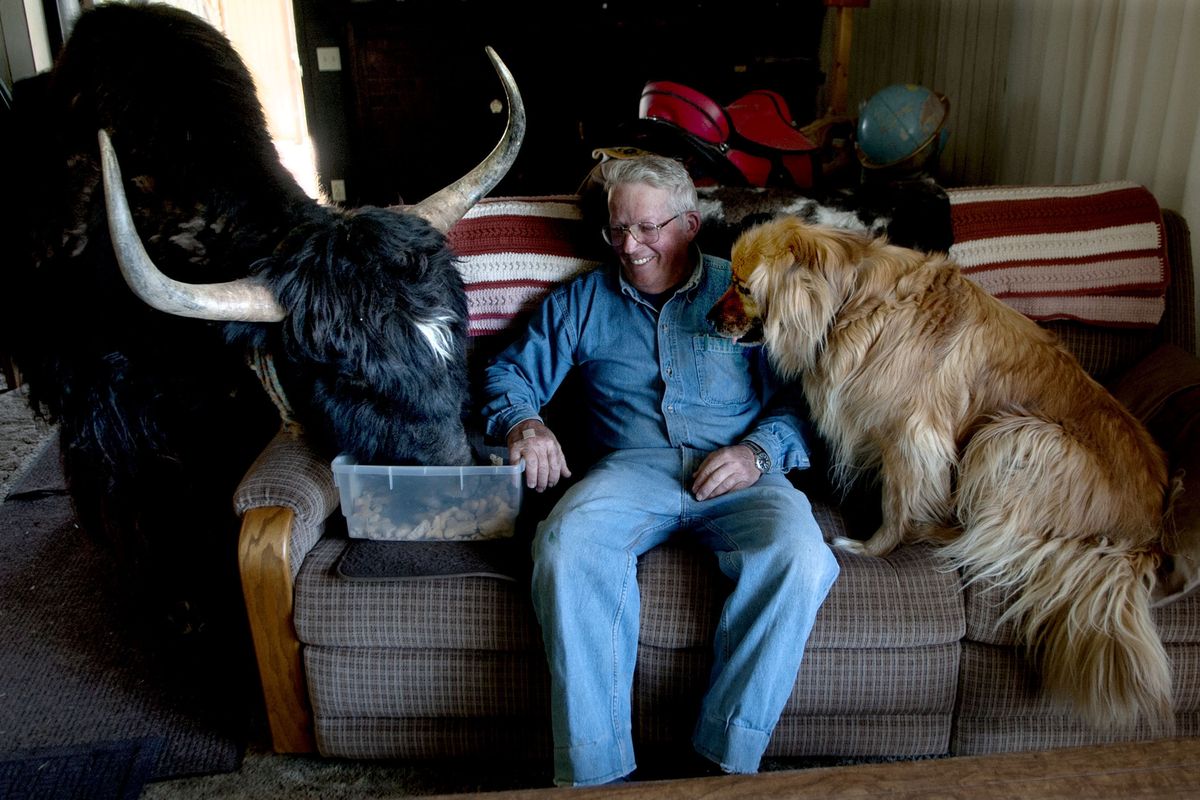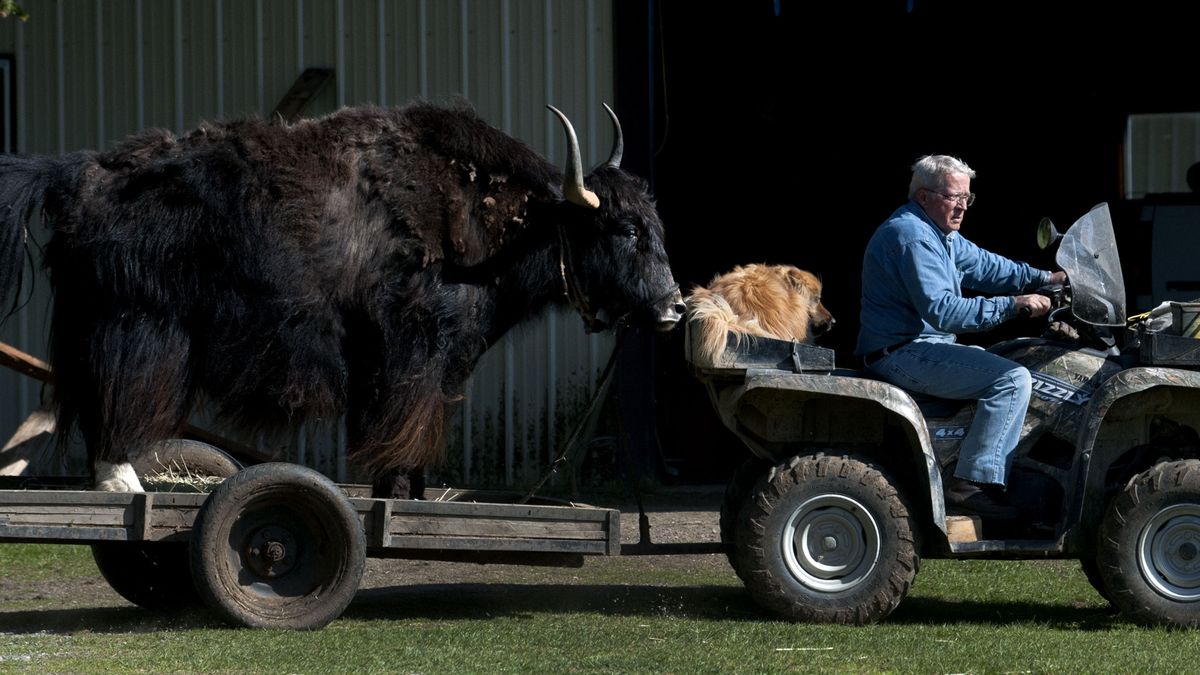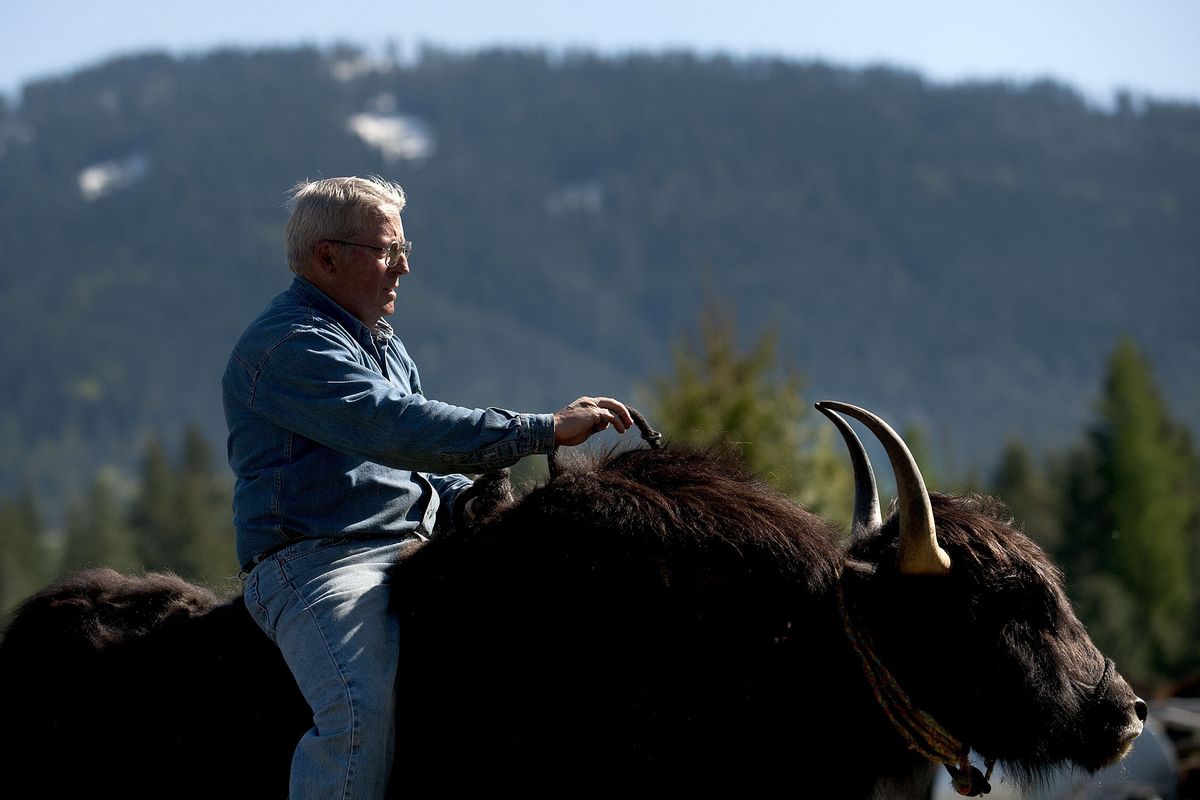Idaho rancher, yak an inseparable duo
Athol resident Lynn Taylor, 69, rides Makloud, his Tibetan yak, around his property on Tuesday. Taylor Ranch Yaks is the largest yak producer in North Idaho. (Kathy Plonka)Buy a print of this photo
When Lynn Taylor retired to North Idaho, he wanted to raise something fun and exotic, not your standard cows or sheep. He had no idea a decade later his “life partner” would be a 1,140-pound Tibetan yak that he rides in the mountains, drives around in a cart behind his ATV and invites into his home for a few dog treats on the couch.
Meet Makloud the Yak, who Taylor raised as a bottle baby after the calf’s mother died.
Now 8, Makloud is like a very large, shaggy dog following Taylor around his ranch where dozens of other not-so-friendly and hospitable yaks live, grown for their meat. Neighbors are accustomed to seeing Taylor, 69, ride Makloud on the local roads near Farragut State Park, usually bareback and using nothing but a halter around the animal’s nose and a lead rope as a rein. Taylor lets just about anyone ride Makloud, especially children. He even dared the UPS driver to take a ride.
“He’s my pride and joy,” Taylor said with an arm draped over Makloud’s neck, fingers scratching the thick wool and no mind to the large, handlebar horns just inches from his face. “He’s the most wonderful thing that’s happened to me. He’s the most unique pet.”
Makloud’s eyes softened as he leaned into the attention. Yet he’s not fool-proof. A large bandage covers the back of Taylor’s hand, evidence of Makloud’s independence and sometimes low tolerance. The yak kicked Taylor recently while he was trying to pull some of the dreadlocks hanging from Macloud’s neck and shoulders, a spring shedding ritual.
“He’s still got a mind of his own, Taylor said.
Sometimes when Makloud is acting obstinate, refusing to go in the pen, Taylor said he will just give the yak a hug. Usually that softens Makloud enough to obey.
Taylor Ranch Yaks is the largest yak producer in North Idaho – not that yak ranching is common, with estimates of only 10,000 yaks in the United States compared to more than 89.3 million beef cattle. Taylor, an engineer who worked for oil companies in Saudi Arabia for years, sells the meat, a dark red delicacy that has just 3.9 percent fat compared with 24 percent for beef and 9 percent for chicken. It sells for about $10 per pound. Taylor yak meat is sold at Pilgrim’s Market in Coeur d’Alene and you can get a yak burger at GW Hunters Steakhouse in Post Falls or the Enaville Resort Snake Pit in Kingston.
When Taylor first moved to Athol in 1989 he thought about raising llamas, but their popularity was waning. Cows were too much work, which he learned as a boy growing up in Southern Idaho near dairy farms. He read an ad in the paper for yaks and drove to Kalispell to check out the exotic bovines. He was instantly mesmerized watching the spirited calves play. He brought home five.
Yaks are native to the Himalayan mountains of Tibet. Because they are cold-climate bovine, using their massive horns to break ice for drinking water and forage through the snow, their fat is located on the outside of the meat, making it easily trimmed and giving it its low fat content and dark red color. It is juicier than bison.
Yaks are grazers and browsers and don’t require grains. Yet it takes up to five years for a yak to be ready for butcher, while beef steers are ready for slaughter in a year. Taylor has his yaks processed in Montana at a state-inspected facility.
Yaks were domesticated by Qiang herdsmen about 4,500 years ago. Tibetan plateau people used every part of the yaks, similar to how American Indians utilized buffalo. People also use yaks for packing and work, such as pulling logs.
They are known for their large horns, bony shoulder humps, horselike tails and long shaggy skirts that hang nearly to the ground. Yak fiber makes a soft, luxurious yarn and is easy to felt. Yaks don’t smell musty, as many people assume.
Harvesting the down is hard work, said Christine Stoneham of Pack River Yaks north of Sandpoint.
“You have to comb the yaks, get the fiber off and usually send it to a miller,” she said.
Then the fiber is cleaned, dehaired and spun into yarn. Besides selling fiber, Stoneham also sells meat, hides and yak skulls. She’s had their yaks for about 10 years, an initial business venture that wasn’t popular with her husband.
“It was my crazy idea,” she said, adding that today her husband loves the yaks.
The couple are often at the Sandpoint and Bonners Ferry farmers markets and their meat is sold both at Di Luna’s restaurant and Pucci Bar and Grill at Schweitzer Mountain Resort. They also have a bottle-fed yak that roams their yard like a pet and occasionally appears in the Sandpoint Fourth of July Parade, carrying a pack.
Harvesting the down is too labor intensive for Taylor. He sticks to selling meat and loving Makloud.
Last week Taylor proudly showed off his herd of mama yaks and their newborns, playing in the morning sun, flipping their hairy tails in the air. The yak cows eyed Taylor suspiciously as he drove through the herd on his four-wheeler. They were keenly aware strangers were present, shaking their horns and grunting a cautious warning to the calves. It was the same reception in a separate pen of bulls and steers, making it overtly obvious Makloud isn’t a typical yak.
“They can be very aggressive,” said Jenni Grimmett of Triton Veterinarian Service, who provides medical care for both Taylor’s and Stoneham’s yaks. “They are a lot more like buffalo than cows. They are very quick with those horns.”
Grimmett, an accomplished horsewoman, has also ridden Makloud.
“I was amazed by how comfortable he was,” Grimmet said, yet she isn’t likely to give up her Morgan horses for yaks.
Usually the “pet” yaks are bonded to humans because they were bottle-fed milk as calves. Taylor bottle-fed Makloud for three years, a lot longer than a yak mother. When he was thirsty, Makloud stared at Taylor through the window. That’s how he started coming in the house. Now he comes to the door when he wants a treat.
No, Makloud isn’t housebroken, but he rarely has an accident. Taylor jokes that’s why his girlfriend won’t move in.
Dixie Kubart rolled her eyes as Makloud gently lumbered out of the house. She’s a city girl raised in Chicago. Even though the yaks intimidate her, she enjoys watching Taylor act like a kid. She shook her head again as Makloud jumped on a trailer hooked to Taylor’s four-wheeler. The duo sped off, Makloud balancing like a skilled skier as they rounded a sharp corner.
“They do this all the time,” Kubart said. “It’s the most remarkable thing.”


